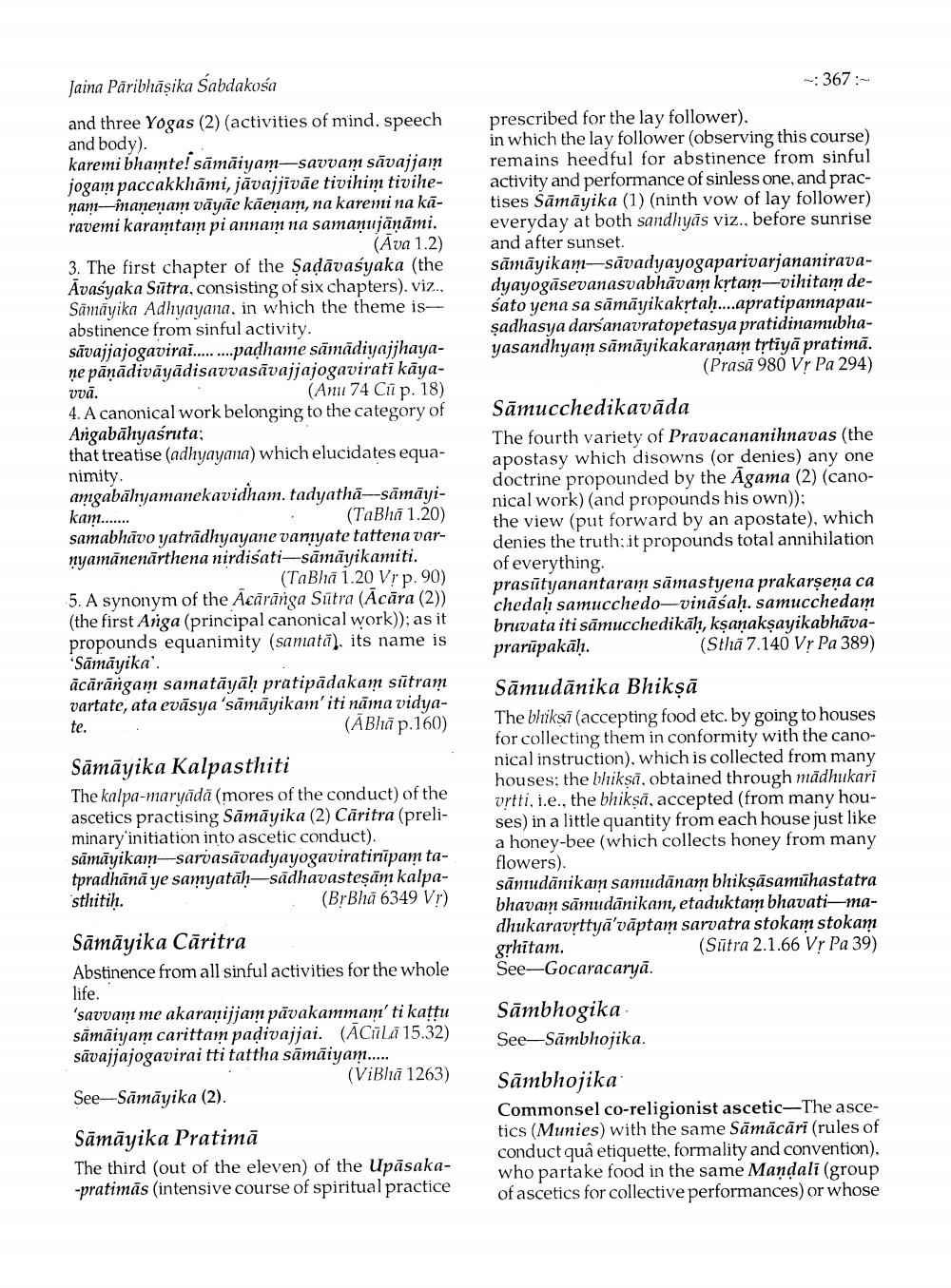________________
367 :
prescribed for the lay follower), in which the lay follower (observing this course) remains heedful for abstinence from sinful activity and performance of sinless one, and practises Sāmāyika (1) (ninth vow of lay follower) everyday at both sandhyās viz., before sunrise and after sunset. sāmāyikam sāvadyayogaparivarjananiravadyayogāsevanasvabhāvam krtam-vihitam deśato yena sa sāmāyikakştah....apratipannapauşadhasya darsanavratopetasya pratidinamubhayasandhyam sāmāyikakaranam tặtiyā pratimā.
(Prasā 980 Vr Pa 294)
Jaina Pāribhāșika Sabdakośa and three Yogas (2) (activities of mind, speech and body). karemi bhamte! sāmāiyam-savvam sāvajjam jogam paccakkhāmi, jāvajjivāe tivihim tivihenam-maņeņam vāyāe kāenam, na karemi na kāravemi karamtain pi annain na samanujānāmi.
(Ava 1.2) 3. The first chapter of the Sadāvasyaka (the Avasyaka Sūtra, consisting of six chapters), viz., Sämāyika Adhyayana, in which the theme isabstinence from sinful activity. sävajjajogavirai.........padhame sāmādiyajjhayane pāņādivāyādisavvasāvajjajogavirati kāyavvā.
(Anu 74 Cu p. 18) 4. A canonical work belonging to the category of Angabāhyaśruta; that treatise (adhyayana) which elucidates equanimity. amgabālnyamanekavidham. tadyathă--sāmāyikam......
. (TaBhā 1.20) samabhāvo yatrādhyayane vamyate tattena varnyamānenārthena nirdisati-sāmāyikamiti.
(Tabha 1.20 Vr p. 90) 5. A synonym of the Acārānga Sūtra (Ācāra (2)) (the first Arga (principal canonical work)); as it propounds equanimity (samata), its name is "Sāmāyika'. ācārāngam samatāyāḥ pratipadakam sūtram vartate, ata eväsya'sāmāyikan' iti nāma vidyate.
(ĀBhā p.160)
Sāmucchedikavāda The fourth variety of Pravacananihnavas (the apostasy which disowns (or denies) any one doctrine propounded by the Agama (2) (canonical work) (and propounds his own)); the view (put forward by an apostate), which denies the truth; it propounds total annihilation of everything prasütyanantaram sāmastyena prakarsena ca chedah samucchedo-vināśaḥ. samucchedam bruvata iti sāmucchedikāh, ksanakşayikabhāvaprarūpakāh.
(Sthā 7.140 Vr Pa 389)
Sāmāyika Kalpasthiti The kalpa-maryādā (mores of the conduct) of the ascetics practising Sāmāyika (2) Caritra (preliminary'initiation into ascetic conduct). sāmāyikam-sarvasāvadyayogaviratinīpam tatpradhānā ye samyatāh-sādhavasteşām kalpasthiti”.
(BrBhā 6349 Vr)
Sāmudānika Bhikṣā The bhiksī (accepting food etc. by going to houses for collecting them in conformity with the canonical instruction), which is collected from many houses; the bhikṣā, obtained through madhukari vrtti, i.e., the bhikṣā, accepted (from many houses) in a little quantity from each house just like a honey-bee (which collects honey from many flowers). sāniudānikam samudānam bhiksāsamuhastatra bhavam sāmudānikam, etaduktam bhavati-madhukaravrttyä'vāptam sarvatra stokam stokam grhitam.
(Sūtra 2.1.66 Vr Pa 39) See-Gocaracaryā.
Sāmāyika Cāritra Abstinence from all sinful activities for the whole
life.
Sāmbhogika See-Sāmbhojika.
'savvam me akaranijjam pāvakammam' ti kattu sāmāiyam carittam padivajjai. (ACHLa 15.32) sāvajjajogavirai tti tattha sāmäiyam...
(ViBhā 1263) See-Sāmāyika (2).
Sāmāyika Pratimā The third (out of the eleven) of the Upāsaka-pratimās (intensive course of spiritual practice
Sāmbhojika Commonsel co-religionist ascetic-The ascetics (Munies) with the same Sāmācāri (rules of conduct quâ etiquette, formality and convention), who partake food in the same Mandali (group of ascetics for collective performances) or whose




